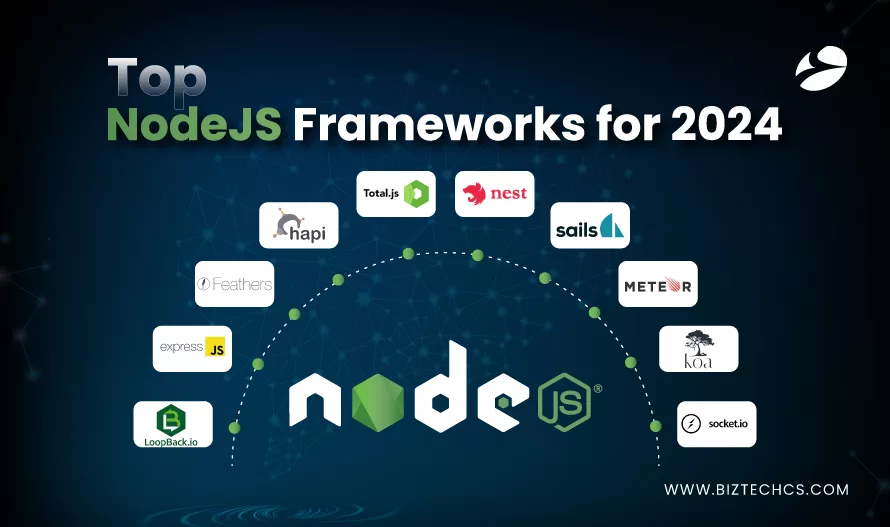3099
Top 7 Node JS Frameworks for Web Development in 2024 and Coming Years
07 Mar, 2024
7 min read
3099
07 Mar, 2024
7 min read
Table of content

Node JS is an open-source, cross-platform runtime JS environment that can run on multiple platforms (Windows, Linux, MacOS, and more). While Javascript was primarily used for client-side scripting, Node JS became one of the few technologies that leveraged JS for running server-side scripts and producing dynamic webpage content.
Various Node.js frameworks further supported the use of the templating engine, middleware, simplified routing, error handling, and so on. In this blog post, we will explore the various Node JS frameworks that make backend development easier for you.
As mentioned, Node JS is a runtime environment that facilitates server-side scripting. However, it is often confused and even alternatively called to be a framework (though it’s not).
In this blog post, whenever we are speaking of top Node.js frameworks, we are referring to the various Javascript frameworks that make development with Node easier, faster, and more efficient. These frameworks are either developed solely for working with Node or can be used with other technologies as well.
These JS frameworks typically fall under categories like web app, full-stack, real-time, and Rest API frameworks. By using these Node.js frameworks,
To be precise, you have access to the latest tools, resources, and community support that helps with the development of unique web applications that meet modern-day demands.
Node.js development frameworks are typically divided into three categories:
These frameworks adhere to the MVC architecture pattern, splitting the app logic into three essential parts – Models, Views, and Controllers. It separates the data layer from the presentation layer and controls logic, helping you develop more effortlessly. Frameworks falling under this category make the most scalable applications.
Examples: Express.js, Feather.js, Koa.js
Besides following the MVC architecture, these frameworks offer extended capabilities of templating engines, libraries, and scaffolding to help with frontend and backend development. Leverage the full-stack frameworks to build real-time web applications.
Examples: Meteor.js, Total.js, Sails.js, Adonis.js, Derby.js
Focused on creating RESTful web services, these frameworks provide tools for building APIs that allow web services to communicate over HTTP, with support for CRUD operations (Create, Read, Update, Delete) using standard HTTP methods (GET, POST, PUT, DELETE). They are ideal for web and mobile app development (backend) that interact with a server via RESTful APIs.
Examples: Loopback, Hapi.js, Nest.js
Here’s a list of popular Javascript frameworks that help with the seamless development of your Node application. Explore the various frameworks, their features, and appropriate uses to see which one will be a better fit for your web app development needs.
Express of Express.js is amongst the most popular backend frameworks developed for building Restful APIs in Node.js. Developed under the MIT license, it is an open-source technology that makes development with Node easier and faster.
Features of Express.js:
Limitations of Express.js:
When to Use Express.js:
When Not to Use Express.js:
The next-gen web framework for Node.js, Koa.js is designed by the creators of Express. The motto behind developing Koa.js was to bring a smaller, more expressive, and more robust foundation for developing web applications and APIs. Since it doesn’t use any middleware like ‘bodyparser’ in its core, it is lightweight and its asynchronous nature helps with improved error-handling capabilities.
Features of Koa.js:
Limitations of Koa.js:
When to Use Koa.js:
When Not to Use Koa.js:
Socket.io is a Javascript library for Node.js that enables real-time, bidirectional, and event-based communication between web clients and servers. It is used especially for developing real-time applications like online gaming, chat applications, collaborative tools, live notifications, etc.
Features of Socket.io:
Limitations of Socket.io:
When to Use Socket.io:
When Not to Use Socket.io:
The open-source Hapi.js framework is known for its improved security and helps develop Rest APIs, proxy servers, and desktop applications. It comes with a range of built-in plugins that extend the framework capabilities in leaps and bounds. Also, you don’t have to rely on any unofficial or third-party middleware for the same reason.
Features of Hapi.js:
Limitations of Hapi.js:
When to Use Hapi.js:
When Not to Use Hapi.js:
It adheres to MVC architecture much like that of Ruby on Rails. With support for multiple databases and modern data-oriented development, it is suitable for developing highly customized, data-heavy Enterprise applications.
Sail.js is a frontend agnostic backend framework, allowing you to present data using any framework of your choice. For HTTP requests, it makes use of Express and uses Socket.io for WebSockets.
Features of Sails.js:
Limitations of Sails.js:
When to Use Sails.js:
When Not to Use Sails.js:
Meteor.js is an open-source, full-stack Javascript framework built on top of Node.js. The framework uses only Javascript to develop apps for multiple operating systems like Android and iOS for mobile and web development.
Its comprehensive set of libraries and testing capabilities makes it suitable for developing real-time applications or apps with high streaming capabilities.
Features of Meteor.js:
Limitations of Meteor.js:
When to Use Meteor.js:
When Not to Use Meteor.js:
Built with TypeScript, Nest.js allows you to code in pure Javascript and combines elements of OOP, Functional reactive Programming, and Functional Programming. Thus, you can expect improved productivity and performance. With a clean code architecture, Nest.js helps build efficient and scalable server-side applications.
Features of Nest.js:
Limitations of Nest.js:
When to Use Nest.js:
When Not to Use Nest.js:
That’s a wrap on some of the best Node.js frameworks we have in 2024!
Do you have any favorites already? Then, we can help you with the next steps of ideation, design, development, deployment, and even maintenance. Hire Node.js developers from a reliable custom software development company like BiztechCS and get the needed technical assistance.
For more information on our expertise and how we can help with your web app idea, Contact Us.
Determining the best Node.js framework hinges on the project’s specific needs, team expertise, and the particular goals at hand. While Express.js shines for its simplicity, flexibility, and widespread use, frameworks like Nest.js and Koa offer more structured environments ideal for complex applications requiring robust architecture and advanced features. On the other hand, Sails.js and Meteor cater to developers looking for full-stack solutions that streamline both front-end and back-end development.
Ultimately, the choice is up to you and your specific needs. Make sure to go by all the features and best use case scenarios and define your project requirements, team capabilities, and long-term vision before settling for a framework.

.NET
20
By Devik Gondaliya
15 Jul, 2025

.NET
25
By Devik Gondaliya
15 Jul, 2025

Odoo
62
By Biztech
15 Jul, 2025